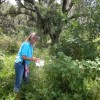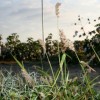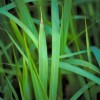 Tropical soda apple is a prickly shrub native to South America. First reported in Glades Co., Florida in 1988, it later spread to Georgia, Alabama, Louisiana, Texas, Mississippi, Tennessee, North Carolina, and South Carolina. It is a major problem in pastures and conservation areas. Negative impacts of tropical soda apple include reduction of cattle stocking rates, competition with native plants, and the costs associated with its control. Dense thickets of the weed also can disrupt the movement of wildlife. This 4-page fact sheet provides a summary of the major steps of the successful biological control program against tropical soda apple in Florida. The article covers the importance of the weed, identification and biology of the biological control agent, rearing and release efforts, establishment and impact, and efforts to communicate the outcomes of the program to stakeholders. Written by R. Diaz, J. Medal, K. Hibbard, A. Roda, A. Fox, S. Hight, P. Stansly, B. Sellers, J. Cuda and W. A. Overholt, and published by the UF Department of Entomology and Nematology, November 2012.
Tropical soda apple is a prickly shrub native to South America. First reported in Glades Co., Florida in 1988, it later spread to Georgia, Alabama, Louisiana, Texas, Mississippi, Tennessee, North Carolina, and South Carolina. It is a major problem in pastures and conservation areas. Negative impacts of tropical soda apple include reduction of cattle stocking rates, competition with native plants, and the costs associated with its control. Dense thickets of the weed also can disrupt the movement of wildlife. This 4-page fact sheet provides a summary of the major steps of the successful biological control program against tropical soda apple in Florida. The article covers the importance of the weed, identification and biology of the biological control agent, rearing and release efforts, establishment and impact, and efforts to communicate the outcomes of the program to stakeholders. Written by R. Diaz, J. Medal, K. Hibbard, A. Roda, A. Fox, S. Hight, P. Stansly, B. Sellers, J. Cuda and W. A. Overholt, and published by the UF Department of Entomology and Nematology, November 2012.
http://edis.ifas.ufl.edu/in971
Tag: Brent A. Sellers
Identification and Control of Southern Sandbur (Cenchrus echinatus L.) in Hayfields (SSAGR364/AG373)
 Southern sandbur is an annual grass that grows in pastures and cropland throughout the warm areas of the southern United States from Virginia to California. This native grass is adapted to dry, sandy soils and has a shallow, fibrous root system. It can easily invade a poorly managed field, diminishing the quality of a hay crop or grazing pasture. Southern sandbur seeds start to germinate in late spring, and germination continues through the summer and fall. Flowering occurs in late fall, and growth is consistent until the first frost. This 2-page fact sheet was written by Hunter Smith, Jason Ferrell, and Brent Sellers, and published by the UF Department of Agronomy, December 2012.
Southern sandbur is an annual grass that grows in pastures and cropland throughout the warm areas of the southern United States from Virginia to California. This native grass is adapted to dry, sandy soils and has a shallow, fibrous root system. It can easily invade a poorly managed field, diminishing the quality of a hay crop or grazing pasture. Southern sandbur seeds start to germinate in late spring, and germination continues through the summer and fall. Flowering occurs in late fall, and growth is consistent until the first frost. This 2-page fact sheet was written by Hunter Smith, Jason Ferrell, and Brent Sellers, and published by the UF Department of Agronomy, December 2012.
http://edis.ifas.ufl.edu/ag373
Cogongrass (Imperata cylindrica) Biology, Ecology, and Management in Florida Grazing Lands (SSAGR52/WG202)
 Cogongrass is found on every continent and is considered a weedy pest in 73 countries. In the U.S., cogongrass is found primarily in the Southeast. It was accidentally introduced into Alabama in the early 1900s, and purposely introduced as a potential forage and soil stabilizer in Florida (and other states) in the 1930s and early 1940s. However, soon after investigations began it was realized that cogongrass could be a weedy pest. Since its introduction, cogongrass has spread to nearly every county in Florida. In some cases, it has completely taken over pastures so that it is the only species present. This is a common thread where cogongrass invades; it quickly displaces desirable species and requires intensive management. This 5-page fact sheet was written by B. A. Sellers, J. A. Ferrell, G. E. MacDonald, K. A. Langeland, and S. L. Flory, and published by the UF Department of Agronomy, August 2012.
Cogongrass is found on every continent and is considered a weedy pest in 73 countries. In the U.S., cogongrass is found primarily in the Southeast. It was accidentally introduced into Alabama in the early 1900s, and purposely introduced as a potential forage and soil stabilizer in Florida (and other states) in the 1930s and early 1940s. However, soon after investigations began it was realized that cogongrass could be a weedy pest. Since its introduction, cogongrass has spread to nearly every county in Florida. In some cases, it has completely taken over pastures so that it is the only species present. This is a common thread where cogongrass invades; it quickly displaces desirable species and requires intensive management. This 5-page fact sheet was written by B. A. Sellers, J. A. Ferrell, G. E. MacDonald, K. A. Langeland, and S. L. Flory, and published by the UF Department of Agronomy, August 2012.
http://edis.ifas.ufl.edu/wg202
Identification and Control of Johnsongrass, Vaseygrass, and Guinea Grass in Pastures (SSAGR363/AG372)
 Johnsongrass is a common weed throughout the South and Midwest. People often incorrectly call any weed johnsongrass, but it is one of three grasses found in Florida pastures. Knowing the differences between johnsongrass, vaseygrass, and guinea grass will help with proper weed management. This 3-page fact sheet was written by H. Smith, J. Ferrell, and B. Sellers, and published by the UF Agronomy Department, August 2012. http://edis.ifas.ufl.edu/ag372
Johnsongrass is a common weed throughout the South and Midwest. People often incorrectly call any weed johnsongrass, but it is one of three grasses found in Florida pastures. Knowing the differences between johnsongrass, vaseygrass, and guinea grass will help with proper weed management. This 3-page fact sheet was written by H. Smith, J. Ferrell, and B. Sellers, and published by the UF Agronomy Department, August 2012. http://edis.ifas.ufl.edu/ag372
Control of Lantana in Pastures (SSAGR359/AG368)
Lantana is currently one of the top 10 most troublesome weeds in Florida. Although it is still sold as an ornamental, commercial varieties are sterile and considered to be non-invasive. It can quickly invade disturbed sites by producing plant toxins in its roots and stems, that either slow the growth of other plants or totally remove them. These leaf toxins are damaging to grazing animals. If animals consume the leaves, they often begin to show symptoms of skin peeling or cracking. Once animals show these symptoms, there is little or no treatment that can reverse the process. Although lantana’s leaves are poisonous, its berries are not. Birds readily consume the fruit and disperse the seed. This 2-page fact sheet was written by J. Ferrell, B. Sellers, and E. Jennings, and published by the UF Department of Agronomy, February 2012.
http://edis.ifas.ufl.edu/ag368
Bracken Fern Control in Pastures (SSAGR357/AG366)
 Bracken fern is a poisonous plant common along tree lines, in forest openings, and around building borders. Animals will consum it when adequate forage is not available. Learn more in this 2-page fact sheet was written by J. Ferrell, B. Sellers, and T. Wilson , and published by the UF Department of Agronomy, December 2011.
Bracken fern is a poisonous plant common along tree lines, in forest openings, and around building borders. Animals will consum it when adequate forage is not available. Learn more in this 2-page fact sheet was written by J. Ferrell, B. Sellers, and T. Wilson , and published by the UF Department of Agronomy, December 2011.
http://edis.ifas.ufl.edu/ag366
Prickly Pear Cactus Control in Pastures (SSAGR354/AG363)
 Prickly pear cactus is not a problem in every pasture in Florida, but where it is found, it is often the biggest and most difficult issue to manage: mowing prickly pear fragments the pads and dramatically increases the infestation, and although prickly pear doesn’t form dense canopies and doesn’t outcompete desirable forage grasses, its impact on grazing can be just as severe because of its barbed quills. This 2-page fact sheet was written by J. A. Ferrell and B. A. Sellers, and published by the UF Department of Agronomy, September 2011.
Prickly pear cactus is not a problem in every pasture in Florida, but where it is found, it is often the biggest and most difficult issue to manage: mowing prickly pear fragments the pads and dramatically increases the infestation, and although prickly pear doesn’t form dense canopies and doesn’t outcompete desirable forage grasses, its impact on grazing can be just as severe because of its barbed quills. This 2-page fact sheet was written by J. A. Ferrell and B. A. Sellers, and published by the UF Department of Agronomy, September 2011.
http://edis.ifas.ufl.edu/ag363
Flat-top Goldenrod (Euthamia caroliniana): Biology and Control in Pastures (SS-AGR-353/AG361)
 This perennial plant, which flowers September – November with flat-topped inflorescence consisting of many yellow ray and disk flowers, is a common weed found in pastures with low levels of management. Learn more in this 3-page fact sheet was written by B. A. Sellers and J. A. Ferrell and published by the UF Department of Agronomy, September 2011.
This perennial plant, which flowers September – November with flat-topped inflorescence consisting of many yellow ray and disk flowers, is a common weed found in pastures with low levels of management. Learn more in this 3-page fact sheet was written by B. A. Sellers and J. A. Ferrell and published by the UF Department of Agronomy, September 2011.
http://edis.ifas.ufl.edu/ag361
Dogfennel (Eupatorium capillifolium): Biology and Control (SSAGR224/AG233)
 Dogfennel is currently the number one most commonly occurring pasture weed in Florida. Many people think it is only unsightly, but it causes significant bahiagrass yield loss and can cause dehydration when ingested by cattle. This 3-page fact sheet was written by B. A. Sellers and J. A. Ferrell and published by the UF Department of Agronomy, September 2011.
Dogfennel is currently the number one most commonly occurring pasture weed in Florida. Many people think it is only unsightly, but it causes significant bahiagrass yield loss and can cause dehydration when ingested by cattle. This 3-page fact sheet was written by B. A. Sellers and J. A. Ferrell and published by the UF Department of Agronomy, September 2011.
http://edis.ifas.ufl.edu/ag233
Fall Panicum: Biology and Control in Sugarcane (SSAGR132/SC079)
 Fall panicum (Panicum dichotomiflorum) is a native grass that can be found throughout the United States in agronomic and horticultural crops, turfgrass, nurseries, landscapes, and noncrop areas. It grows well in warm wet conditions and is one of the most common grass weeds found in Florida sugarcane. This 3-page fact sheet provides sugarcane growers with guidance on its identification and control. Written by D.C. Odero, Brent Sellers, Les Baucum, and Curtis Rainbolt, and published by the UF Department of Agronomy, May 2011.
Fall panicum (Panicum dichotomiflorum) is a native grass that can be found throughout the United States in agronomic and horticultural crops, turfgrass, nurseries, landscapes, and noncrop areas. It grows well in warm wet conditions and is one of the most common grass weeds found in Florida sugarcane. This 3-page fact sheet provides sugarcane growers with guidance on its identification and control. Written by D.C. Odero, Brent Sellers, Les Baucum, and Curtis Rainbolt, and published by the UF Department of Agronomy, May 2011.
http://edis.ifas.ufl.edu/sc079
Biology and Control of Common Ragweed Along Ditch and Canal Banks (SSAGR346/AG356)
Common ragweed is a successful pioneer species widely distributed throughout the continental United States. In cultivated fields it will compete with crops for light, moisture, nutrients, and space and will result in significant yield losses. Additionally, allergenic airborne pollen from common ragweed is a primary cause of hay fever and thus a public health concern. This 3-page fact sheet describes the life cycle of the plant and provides management recommendations. Written by D.C. Odero, B. Sellers, and J. Ferrell, and published by the UF Department of Agronomy, April 2011.
http://edis.ifas.ufl.edu/ag356
Saw Palmetto Control: Individual Plant and Broadcast Application (SSAGR341/AG351)
Saw palmetto is a shrubby palm species native to Florida and common throughout the state. Despite its beneficial uses, saw palmetto is a serious weed problem in pastures, forests, and non-cropland areas, and control of this common native plant is often necessary. This 4-page fact sheet provides mechanical and chemical control recommendations. Written by Brandon Fast, Jason Ferrell, and Brent Sellers, and published by the UF Department of Agronomy, March 2011.
http://edis.ifas.ufl.edu/ag351
Biology and Control of Ragweed Parthenium in Non-Cropland (SSAGR343/AG353)
Ragweed parthenium is considered a noxious weed in many parts of the world because of its allelopathic effect on other plants and the health risks it poses to humans. It causes allergic contact dermatitis, rhinitis, and respiratory problems in sensitive humans. Learn more in this 3-page fact sheet was written by D.C. Odero, B.A. Sellers, and J.A. Ferrell, and published by the UF Department of Agronomy, April 2011.
http://edis.ifas.ufl.edu/ag353
Managing Against the Development of Herbicide-Resistant Weeds: Sugarcane (SSAGR244/SC077)
Although it is likely that small populations of herbicide-resistant weeds are already present in the Everglades Agricultural Area (EAA), herbicide resistance is currently not a significant problem. The continued use of integrated and properly managed weed control programs should ensure that resistance does not become a major issue in the future. In order to successfully manage herbicides against the development of herbicide-resistant weeds, you must have a basic understanding of which herbicides have the same site of action. This revised 4-page fact sheet lists herbicides by group number, site of action, chemical family, common name, and trade name.
Written by D.C. Odero, B.A. Sellers, J.A. Ferrell, and G.E. MacDonald, and published by the UF Department of Agronomy, March 2011.
http://edis.ifas.ufl.edu/sc077
Mulato II (Brachiaria sp.) (SSAGR303/AG310)
Mulato II is a semi-erect perennial apomictic grass that can grow up to 9 ft tall. Brachiariagrasses, including Mulato II, are tropical warm-season forages native to Africa and are the most widely grown forages in tropical South America. This 4-page fact sheet describes teh morphology, region of adaptation and growing season in Florida, recommended production practices, and the results of research into the performance of heifers grazing Mulato. Written by J. Vendramini, B. Sellers, L.E. Sollenberger, and M. Silveira, and published by the UF Department of Agronomy, March 2011.
http://edis.ifas.ufl.edu/ag310
SSAGR334/AG344 Weed Management in Limpograss
SSAGR344, a 3-page fact sheet by Brent Sellers and Jason Ferrell, clarifies recommendations for weed control in limpograss pastures and hayfields. Published by the UF Department of Agronomy, May 2010.
http://edis.ifas.ufl.edu/ag344
SSAGR87/AG267 Forage Grass Tolerance to Pasture Herbicides
Revised! SS-AGR-87, a 2-page illustrated fact sheet by Brent A. Sellers and Jason A. Ferrell, describes the tolerance of forage cultivars grown in Florida to herbicides currently registered for use in pastures. Published by the UF Department of Agronomy, May 2010.
http://edis.ifas.ufl.edu/ag267
SSAGR08/WG006 Weed Management in Pastures and Rangeland – 2010
SSAGR08, an 18 page fact sheet by B.A. Sellers and J.A. Ferrell, describes an integrated approach to weed management in pastures and rangeland that involves scouting, prevention, and control (biological, cultural, mechanical, and chemical) in a coordinated plan. Published by the UF Department of Agronomy, February 2010.
http://edis.ifas.ufl.edu/wg006
SSAGR257/AG243 Managing Bahiagrass in Bermudagrass and Stargrass Pastures
Revised! SS-AGR-257, a 4-page illustrated fact sheet by B. A. Sellers and J. A. Ferrell, describes how to prevent encroachment by bahiagrassinto bermudagrass and stargrass pastures in Florida, and provides recommendations for chemical control, the impact of herbicide applications, and how to reduce forage-yield loss. Published by the UF Department of Agronomy, November 2009.
http://edis.ifas.ufl.edu/AG243
SSAGR328/AG338 Mile-a-minute (Mikania micrantha): A New Weed in South Florida
SSAGR328, a 2-page illustrated fact sheet by Brent Sellers and Ken Langeland, describes this new weed, a highly branched perennial vine, reported in late 2009 near Homestead FL, and how to identify it and what to do if you find it. Published by the UF Department of Agronomy, January 2010.
http://edis.ifas.ufl.edu/ag338